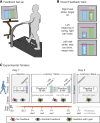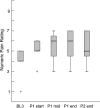Acute pain impairs retention of locomotor learning
- PMID: 38381551
- PMCID: PMC11305642
- DOI: 10.1152/jn.00343.2023
Acute pain impairs retention of locomotor learning
Abstract
Despite abundant evidence that pain alters movement performance, considerably less is known about the potential effects of pain on motor learning. Some of the brain regions involved in pain processing are also responsible for specific aspects of motor learning, indicating that the two functions have the potential to interact, yet it is unclear if they do. In experiment 1, we compared the acquisition and retention of a novel locomotor pattern in young, healthy individuals randomized to either experience pain via capsaicin and heat applied to the lower leg during learning or no stimulus. On day 1, participants learned a new asymmetric walking pattern using distorted visual feedback, a paradigm known to involve mostly explicit re-aiming processes. Retention was tested 24 h later. Although there were no differences in day 1 acquisition between groups, individuals who experienced pain on day 1 demonstrated reduced retention on day 2. Furthermore, the degree of forgetting between days correlated with pain ratings during learning. In experiment 2, we examined the effects of a heat stimulus alone, which served as a control for (nonpainful) cutaneous stimulation, and found no effects on either acquisition or retention of learning. Thus, pain experienced during explicit, strategic locomotor learning interferes with motor memory consolidation processes and does so most likely through a pain mechanism and not an effect of distraction. These findings have important implications for understanding basic motor learning processes and for clinical rehabilitation, in which painful conditions are often treated through motor learning-based interventions.NEW & NOTEWORTHY Pain is a highly prevalent and burdensome experience that rehabilitation practitioners often treat using motor learning-based interventions. Here, we showed that experimental acute pain, but not a heat stimulus, during locomotor learning impaired 24-h retention of the newly learned walking pattern. The degree of retention loss was related to the perceived pain level during learning. These findings suggest important links between pain and motor learning that have significant implications for clinical rehabilitation.
Keywords: capsaicin; consolidation; locomotion; motor learning; walking.
Conflict of interest statement
No conflicts of interest, financial or otherwise, are declared by the authors.
Figures







Similar articles
-
Acute pain impairs retention of locomotor learning, regardless of the context of retention testing.J Neurophysiol. 2025 Jun 1;133(6):1807-1814. doi: 10.1152/jn.00502.2024. Epub 2025 May 14. J Neurophysiol. 2025. PMID: 40366338 Free PMC article. Clinical Trial.
-
Short-Term Memory Impairment.2024 Jun 8. In: StatPearls [Internet]. Treasure Island (FL): StatPearls Publishing; 2025 Jan–. 2024 Jun 8. In: StatPearls [Internet]. Treasure Island (FL): StatPearls Publishing; 2025 Jan–. PMID: 31424720 Free Books & Documents.
-
The Black Book of Psychotropic Dosing and Monitoring.Psychopharmacol Bull. 2024 Jul 8;54(3):8-59. Psychopharmacol Bull. 2024. PMID: 38993656 Free PMC article. Review.
-
Sexual Harassment and Prevention Training.2024 Mar 29. In: StatPearls [Internet]. Treasure Island (FL): StatPearls Publishing; 2025 Jan–. 2024 Mar 29. In: StatPearls [Internet]. Treasure Island (FL): StatPearls Publishing; 2025 Jan–. PMID: 36508513 Free Books & Documents.
-
Rehabilitation for ankle fractures in adults.Cochrane Database Syst Rev. 2024 Sep 23;9(9):CD005595. doi: 10.1002/14651858.CD005595.pub4. Cochrane Database Syst Rev. 2024. PMID: 39312389
Cited by
-
Acute pain impairs retention of locomotor learning, regardless of the context of retention testing.J Neurophysiol. 2025 Jun 1;133(6):1807-1814. doi: 10.1152/jn.00502.2024. Epub 2025 May 14. J Neurophysiol. 2025. PMID: 40366338 Free PMC article. Clinical Trial.
References
-
- Schmidt RA, Lee TD. Motor Control and Learning: A Behavioral Emphasis. Champaign IL: Human Kinetics, 2011.
Publication types
MeSH terms
Grants and funding
LinkOut - more resources
Full Text Sources

